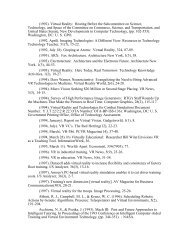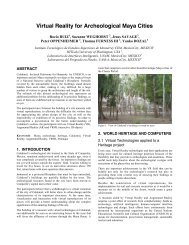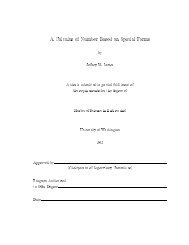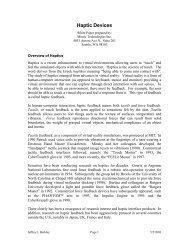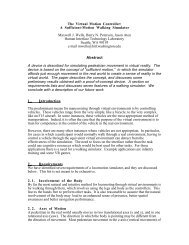Henry B - Human Interface Technology Laboratory - University of ...
Henry B - Human Interface Technology Laboratory - University of ...
Henry B - Human Interface Technology Laboratory - University of ...
Create successful ePaper yourself
Turn your PDF publications into a flip-book with our unique Google optimized e-Paper software.
various widths, found that self-motion was most frequently reported at FOV eccentricities <strong>of</strong> 50º and 60º,<br />
with the slower angular velocities <strong>of</strong> 10º/sec - 15º/sec proving most effective. Howard and Heckmann<br />
(1989) reported that when stimuli were presented in the peripheral visual field, the self-motion<br />
experienced by subjects was stronger than when the stimuli were presented in the central visual field.<br />
However, vection was reduced when the central stimuli moved opposite to the direction <strong>of</strong> the peripheral<br />
stimuli. Howard, Ohmi, Simpson, and Landolt (1987) reported that strong vection could be evoked by a<br />
centrally located moving pattern if that pattern was perceived as being more distant than a stationary<br />
surround. Vection appears to be strongly related to the perceptual distinction between foreground and<br />
background.<br />
Warren and Kurtz (1992) reviewed several experiments that contradicted Brandt’s et al. (1973)<br />
peripheral dominance hypothesis – that peripheral vision is specialized for self-motion perception. Based<br />
on studies <strong>of</strong> perceived heading accuracy, Warren and Kurtz found that the periphery is less sensitive to<br />
radial optical flow than the central region. Even FOVs as small as 10°-25° evoked self-motion<br />
perception. St<strong>of</strong>fregen (1985) reported that postural adjustments were evoked by either radial or parallel<br />
(lamellar) optical flow in the central visual field but only by lamellar flow in the periphery. Anderson and<br />
Braunstein (1985) found that with a display subtending angle as small as 7.5°, subjects still reported<br />
vection and motion sickness. They suggested that representation <strong>of</strong> motion in depth might be the critical




